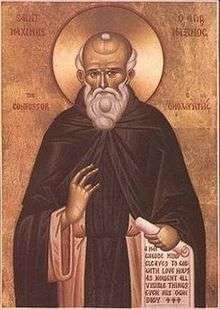May 29 (Eastern Orthodox liturgics)
May 28 - Eastern Orthodox Church calendar - May 30
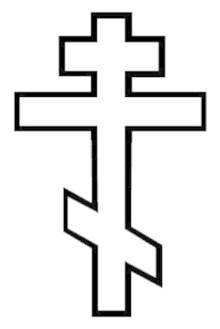
The Eastern Orthodox cross
All fixed commemorations below celebrated on June 11 by Orthodox Churches on the Old Calendar.[note 1]
For May 29th, Orthodox Churches on the Old Calendar commemorate the Saints listed on May 16.
Saints
- Martyr Cyril of Caesarea in Cappadocia (251)[1][note 2]
- Child-martyr Carellus, with martyrs Primolus, Phinodus, Venustus, Gissinus, Alexander, Tredentius, and Jocunda, at Caesarea in Cappadocia (253-259)[2]
- Hieromartyr Olbian, Bishop of Anaea, and his disciples, in Asia Minor (284-303)[2][3][note 3]
- Virgin-martyr Theodosia of Tyre (308)[5][6][note 4]
- Martyrs Andrew (Andras) and his spouse.[8]
- Saint Alexander of Alexandria, Patriarch of Alexandria (326)[2][9]
- Venerable Jeremiah of Damascus.[10][note 5]
- Venerable Virgin-martyr Theodosia of Constantinople (730)[11][12]
Pre-Schism Western saints
- Martyr Restitutus, at Rome, on the Via Aurelia (299).[13][14]
- Saint Maximinus of Trier, Bishop of Trier in Germany (352)[15][16][note 6]
- Martyrs Sisinius, Martyrius, and Alexander, near Trent, in the time of Emperor Honorius (397)[14][16][17][note 7]
- Saint Maximus of Verona, Bishop of Verona in Italy (6th century)[14][16][18]
- Venerable Votus, Felix and John, hermits in the Pyrenees (750)[16][19][note 8]
- Saint John de Atares (750)[16][note 9]
- Saint Ethelbert the King (Æthelberht II of East Anglia) (794)[20] (see also May 20)
- Saint Gerald, a monk at Brou, became Bishop of Mâcon, returned to his monastery 40 years later and reposed there (927)[16]
- Saint Ulric of Einsiedeln (978)[16][note 10]
- Saint Eleutherius of Rocca d'Arce, Confessor, at Arcano in Lazio.[14][16]
Post-Schism Orthodox saints
- * Righteous John and Mary of Ustiug (Vologda) (13th century)[2][5]
- Venerable Helena Dragaš (Hypomone, Ipomoni of Loutraki) (1450)[21]
- Blessed Constantine XI Palaiologos, last Byzantine emperor, martyred by the Ottoman Turks (1453)[2][5][note 11]
- New Martyr Andrew of Argentes, in Chios (1465)[2][23]
- Blessed John of Ustiug, Fool-for-Christ (1494)[24][25]
- New Martyr John (or Nannus) of Smyrna (1802)[26][note 12]
- New Hieromartyr Euthymios (Agritellis) of Zela, in Pontus, Bishop (1921)[27][note 13]
- New Hiero-confessor Luke (Voino-Yasenetsky), Archbishop of Simferopol and Crimea and Surgeon, Unmercenary Wonderworker (1961)[29][30] (see also June 11)
Other commemorations
Icon gallery
 Icon of Pope Alexander of Alexandria.
Icon of Pope Alexander of Alexandria.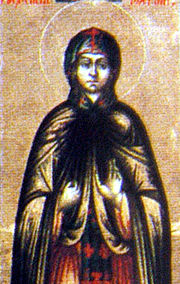
 Church of St. Maximin, in Trier, Germany.
Church of St. Maximin, in Trier, Germany.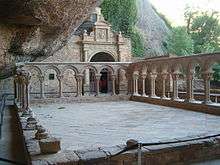 The monastery of St. John de Atares (San Juan de la Peña (of the rock)) is located at the south-west of Jaca, in Huesca, Spain. It was one of the most important monasteries in Aragon in the Middle Ages.
The monastery of St. John de Atares (San Juan de la Peña (of the rock)) is located at the south-west of Jaca, in Huesca, Spain. It was one of the most important monasteries in Aragon in the Middle Ages.
- Empress Helena Dragaš (St. Ipomoni of Loutraki) with Emperor Manuel II Palaiologos, and three of their sons, John, Andronikos and Theodore.
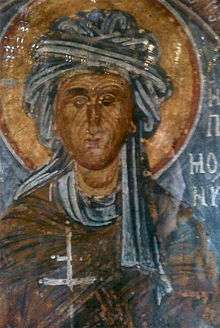 Icon of Helena Dragaš (St. Ipomoni of Loutraki), in the cave of Saint Patapios in Loutraki - Greece.
Icon of Helena Dragaš (St. Ipomoni of Loutraki), in the cave of Saint Patapios in Loutraki - Greece.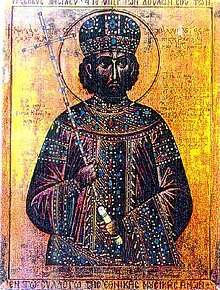 Blessed Constantine XI Palaiologos.
Blessed Constantine XI Palaiologos. Blessed Emperor Constantine XI Palaiologos, last Byzantine emperor.
Blessed Emperor Constantine XI Palaiologos, last Byzantine emperor. Supplication of St. Procopius and St. John of Ustiug at the Icon of the Annunciation.
Supplication of St. Procopius and St. John of Ustiug at the Icon of the Annunciation._of_Zela.jpg) New Hieromartyr Euthymios (Agritellis) of Zela.
New Hieromartyr Euthymios (Agritellis) of Zela..jpg) St. Luke (Voino-Yasenetsky), Archbishop of Simferopol and Crimea and Surgeon, Unmercenary Wonderworker.
St. Luke (Voino-Yasenetsky), Archbishop of Simferopol and Crimea and Surgeon, Unmercenary Wonderworker..jpg) St. Luke (Voino-Yasenetsky), Archbishop of Simferopol and Crimea and Surgeon, Unmercenary Wonderworker.
St. Luke (Voino-Yasenetsky), Archbishop of Simferopol and Crimea and Surgeon, Unmercenary Wonderworker.
Notes
- The notation Old Style or (OS) is sometimes used to indicate a date in the Julian Calendar (which is used by churches on the "Old Calendar").
The notation New Style or (NS), indicates a date in the Revised Julian calendar (which is used by churches on the "New Calendar"). - He was born into a pagan family from Cappadocia, but was baptized at a young age in secret from his parents. When his father found this out, he banished him from the family estate. The local magistrate tried to force him to renounce Christ and sacrifice to idols, but the saint remained steadfast in his faith, and was martyred by beheading in 251 AD.
- "OLBIANUS, a bishop, whose martyrdom by fire in the reign of Maximian for refusing to sacrifice to Juno, is commemorated in the Basilian Menology, May 4 and 29. In one place the see is Anea and the persecutor is the hegemon Julius; in the other Aelianus, hegemon of Asia, persecutes. In the Menologium Græcorum, May 29, the imperial reign is the same, the consuls are Alexander and Maximus, the praesides Julius and Aelianus. A synaxary given by Boll. Acta SS. 29 Mai. vi. 101, twice mentions the same. Under 4 Mai. i. 458, Henschen quotes all the Greek sources, including the Menaea for May 29. He makes Olbianus the Latin Ulpianus, and fixes Anea or Enen on the Carian coast opposite Samos, under the Metropolitan of Ephesus, in the province of Asia. (Cf. Le Quien, Or. Chr. i. 717)."[4]
- The Holy Martyress Theodosia of Tyre suffered in the year 308. On 29 May is celebrated the transfer of her relics to Constantinople, and later on to Venice.[7]
- He is listed among the saints of the Church of Antioch.
- Born in Silly near Poitiers in France, he was a brother of St Maxentius of Poitiers. In 333 he became Bishop of Trier in Germany and was the valiant defender and host of St Athanasius of Alexandria and St Paul of Constantinople, exiled by the Arian Emperor. He was a prominent opponent of Arianism at the Councils of Milan, Sardica and Cologne and one of the most courageous bishops of his time.
- By tradition from Cappadocia, they were received by St Vigilius of Trent in Italy on the recommendation of St Ambrose. They were sent to enlighten the Tyrol in Austria and martyred by pagans.
- Votus and Felix were brothers from Saragossa in Spain who found a hermitage in the Pyrenees which was already inhabited by John (John de Atares). The three lived together and reposed at about the same time. The hermitage was situated beneath a huge rock (Peña) where the monastery of St John de la Peña later grew up.
- A hermit in the Pyrenees in Spain. He lived beneath a huge rock, where the monastery of St John de Ia Peña (of the Rock) was later built. This is famous in Spanish history, since the monastery became the cradle of the Kingdoms of Navarre and Aragon.
- Son of St Gerold, he became a monk at the monastery of Einsiedeln in Switzerland. After his father's death he retired to live as a hermit in the latter's cell.
- On this date in 1453, Constantinople, the capital city of the Christian world, was sacked by the forces of Sultan Mehmet (Mohammed) II, bringing it under Turkish rule, where it remains to this day. Constantine XII, the last Byzantine Emperor, died defending the city. Sources are sharply divided as to whether he is to be counted as a Christian Martyr. The designation "Blessed Constantine", above, is from the St. Herman Calendar, whose compilers cite Russian martyrologies which list him as a saint. However, the Prologue cites the fall of Constantinople while pointedly omitting any praise of Constantine. He accepted (and never publicly renounced) the false "union" of Florence, and so is counted by some as a heretic. Many Orthodox Christians, including many of the people of Constantinople, saw the city's fall as divine retribution for the Empire's acceptance of the union. Before his death the Emperor donned soldier's armor and helped to man the ramparts of the City; his body was never found. Though various legends abound, the most likely explanation is that he died with many other defenders and was cast with them into a common grave.[22]
- The Holy Martyr John (Nannos) of Soluneia (Thessalonika) was martyred by the Turks in the year 1802 in the city of Smyrna.
- The new-martyr Saint Euthymios, known in the world as Agritellis, was born in 1872 in Parakoila on Lesvos, where he started his education. At the age of nine, he entered Leimonos monastery as a child and was tonsured a monk eight years later, in 1899. He completed his general education at the monastery, and was then sent by the brotherhood to the Theological School of Halki, where he studied from 1900 to 1907. After his graduation, he returned to the monastery, having been ordained as a deacon. He then became a teacher, and was head of the Leimonos School. In 1908 he was ordained priest, and from 1911 until his death on May 1921, served the people of the diocese of Zela on the Pontus as their Bishop. It was because of his actions in support of the Greek side in the War in Asia Minor that he was captured by the Turkish armed forces on January 21, 1921. After suffering terrible tortures he gave up his soul to the Lord on May 29th, 1921.[28]
- The Icon of the Mother of God "Non-Slumbering Eye" ("Nedremliuschee Oko") was presented as a gift offering by the daughter of a former preacher Rodion Putyatin, and situated in a monastery chapel in the city of Rybinsk. The wonderworking image was famed for numerous healings. The title "Non-Slumbering Eye" bestown upon the icon is in connection with the inscription beneathe the image: "I may sleep, but My heart is awake" (Song of Solomon 5:2).[33]
- The Icon of the Mother of God "Imperial" ("Tsesarkaya") Borovsk is known of from the 12th century. At first the wonderworking image appeared in the locality of Usvyat, Vitebsk district. The icon was found nearby a cemetery church, located in the vicinity of Bor, from whence it received the name Borovsk. The Imperial-Tsesarsk is called such because it was a copy from the ancient wonderworking Imperial Icon, glorified in the year 792 (commemorated April 9). From the cemetery church the icon was transferred to the Saviour-Transfiguration church at Usvyat. About the miraculous signs and healings from the image of the Mother of God, numerous accounts are preserved. In 1859 at Usvyat and its surroundings there raged a cholera epidemic, taking away many lives. With deep faith the inhabitants turned for help to the image of the Heavenly Queen, and the sickness ceased. In that same year of 1859 the MostHoly Synod established the celebration of the Tsesarsk-Borovsk Icon of the Mother of God under 29 May.[34]
gollark: What if my gender is best expressed using hyperreal numbers?
gollark: What if my gender contains ordinals?
gollark: What if my gender is a sedenion?
gollark: Sounds unsafe.
gollark: What is the type of `GenderError`?
References
- Great Synaxaristes (in Greek) Ὁ Ἅγιος Κύριλλος ἐκ Καισαρείας. 29 Μαΐου. ΜΕΓΑΣ ΣΥΝΑΞΑΡΙΣΤΗΣ.
- May 29/June 11. Orthodox Calendar (PRAVOSLAVIE.RU).
- Great Synaxaristes (in Greek) Ὁ Ἅγιος Ὀλβιανὸς ὁ Ἱερομάρτυρας καὶ οἱ μαθητὲς αὐτοῦ. 29 Μαΐου. ΜΕΓΑΣ ΣΥΝΑΞΑΡΙΣΤΗΣ.
- Rev. Charles Hole, B.A. (Lecturer in Ecclesiastical History at King’s College, London). "OLBIANUS". In: Willian Smith and Henry Wace. A Dictionary of Christian Biography, Literature, Sects and Doctrines. Volume IV: N-Z. London: John Murray, Albemarle Street, 1887. Page 72.
- June 11 / May 29. HOLY TRINITY RUSSIAN ORTHODOX CHURCH (A parish of the Patriarchate of Moscow).
- Great Synaxaristes (in Greek) Ἡ Ἁγία Θεοδοσία ἡ Παρθενομάρτυς. 29 Μαΐου. ΜΕΓΑΣ ΣΥΝΑΞΑΡΙΣΤΗΣ.
- The Holy Martyress Theodosia of Tyre. HOLY TRINITY RUSSIAN ORTHODOX CHURCH (A parish of the Patriarchate of Moscow).
- Great Synaxaristes (in Greek) Οἱ Ἅγιοι Ἄνδρας καὶ ἡ Σύζυγος αὐτοῦ οἱ Μάρτυρες. 29 Μαΐου. ΜΕΓΑΣ ΣΥΝΑΞΑΡΙΣΤΗΣ.
- Great Synaxaristes (in Greek) Ὁ Ἅγιος Ἀλέξανδρος Πατριάρχης Ἀλεξανδρείας. 29 Μαΐου. ΜΕΓΑΣ ΣΥΝΑΞΑΡΙΣΤΗΣ.
- Great Synaxaristes (in Greek) Ὁ Ὅσιος Ἱερεμίας ὁ Δαμασκηνός. 29 Μαΐου. ΜΕΓΑΣ ΣΥΝΑΞΑΡΙΣΤΗΣ.
- Great Synaxaristes (in Greek) Ἡ Ἁγία Θεοδοσία ἡ Ὁσιομάρτυς ἡ Κωνσταντινουπολίτισσα. 29 Μαΐου. ΜΕΓΑΣ ΣΥΝΑΞΑΡΙΣΤΗΣ.
- Virginmartyr Theodosia the Nun of Constantinople. OCA - Feasts and Saints.
- Great Synaxaristes (in Greek) Ὁ Ἅγιος Ρεστιτοῦτος ὁ Μάρτυρας. 29 Μαΐου. ΜΕΓΑΣ ΣΥΝΑΞΑΡΙΣΤΗΣ.
- May 29. The Roman Martyrology.
- Great Synaxaristes (in Greek) Ὁ Ἅγιος Μαξιμίνος Ἐπίσκοπος Τρεβήρων. 29 Μαΐου. ΜΕΓΑΣ ΣΥΝΑΞΑΡΙΣΤΗΣ.
- May 29. Latin Saints of the Orthodox Patriarchate of Rome.
- Great Synaxaristes (in Greek) Ὁ Ἅγιος Σισίννιος ὁ Ἱερομάρτυρας καὶ οἱ σὺν αὐτῷ. 29 Μαΐου. ΜΕΓΑΣ ΣΥΝΑΞΑΡΙΣΤΗΣ.
- Great Synaxaristes (in Greek) Ὁ Ἅγιος Μάξιμος Ἐπίσκοπος Βερόνας. 29 Μαΐου. ΜΕΓΑΣ ΣΥΝΑΞΑΡΙΣΤΗΣ.
- Great Synaxaristes (in Greek) Οἱ Ὅσιοι Βότος, Φήλικας καὶ Ἰωάννης οἱ Ἐρημίτες. 29 Μαΐου. ΜΕΓΑΣ ΣΥΝΑΞΑΡΙΣΤΗΣ.
- Great Synaxaristes (in Greek) Ὁ Ἅγιος Ἐθελμπέρτος ὁ βασιλεύς. 29 Μαΐου. ΜΕΓΑΣ ΣΥΝΑΞΑΡΙΣΤΗΣ.
- Great Synaxaristes (in Greek) Ἡ Ὁσία Ὑπομονή. 29 Μαΐου. ΜΕΓΑΣ ΣΥΝΑΞΑΡΙΣΤΗΣ.
- Blessed Constantine XII, last of the Byzantine emperors, martyred by the Turks (1453). HOLY TRINITY RUSSIAN ORTHODOX CHURCH (A parish of the Patriarchate of Moscow).
- Great Synaxaristes (in Greek) Ὁ Ἅγιος Ἀνδρέας ὁ Νεομάρτυρας ὁ Ἀργέντης. 29 Μαΐου. ΜΕΓΑΣ ΣΥΝΑΞΑΡΙΣΤΗΣ.
- Great Synaxaristes (in Greek) Ὁ Ἅγιος Ἰωάννης ὁ διὰ Χριστὸν Σαλός. 29 Μαΐου. ΜΕΓΑΣ ΣΥΝΑΞΑΡΙΣΤΗΣ.
- Blessed John, Fool-for-Christ, Ustiug Wonderworker. HOLY TRINITY RUSSIAN ORTHODOX CHURCH (A parish of the Patriarchate of Moscow).
- Great Synaxaristes (in Greek) Ὁ Ἅγιος Ἰωάννης ὁ Νεομάρτυρας ὁ Νάννος. 29 Μαΐου. ΜΕΓΑΣ ΣΥΝΑΞΑΡΙΣΤΗΣ.
- Great Synaxaristes (in Greek) Ὁ Ἅγιος Εὐθύμιος ὁ Ἱερομάρτυρας Ἐπίσκοπος Ζήλων. 29 Μαΐου. ΜΕΓΑΣ ΣΥΝΑΞΑΡΙΣΤΗΣ.
- St. Efthymios Agritellis Archived 2012-03-07 at the Wayback Machine. Holy Patriarchal and Stavropegial Leimonos Monastery.
- Great Synaxaristes (in Greek) Ὁ Ἅγιος Λουκᾶς Ἀρχιεπίσκοπος Κριμαίας. 29 Μαΐου. ΜΕΓΑΣ ΣΥΝΑΞΑΡΙΣΤΗΣ.
- (in Russian) 29 мая (ст.ст.) 11 июня 2013 (нов. ст.). Русская Православная Церковь Отдел внешних церковных связей. (DECR).
- Great Synaxaristes (in Greek) Σύναξις Ὑπεραγίας Θεοτόκου «ἡ Ἐγγύηση τῶν Ἁμαρτωλῶν». 29 Μαΐου. ΜΕΓΑΣ ΣΥΝΑΞΑΡΙΣΤΗΣ.
- The Icon of the Mother of God "Pledge for Sinners" ("Sporuchnitsa Greshnukh"). HOLY TRINITY RUSSIAN ORTHODOX CHURCH (A parish of the Patriarchate of Moscow).
- The Icon of the Mother of God "Non-Slumbering Eye" ("Nedremliuschee Oko"). HOLY TRINITY RUSSIAN ORTHODOX CHURCH (A parish of the Patriarchate of Moscow).
- The Icon of the Mother of God "Imperial" ("Tsesarkaya") Borovsk. HOLY TRINITY RUSSIAN ORTHODOX CHURCH (A parish of the Patriarchate of Moscow).
Sources
- May 29/June 11. Orthodox Calendar (PRAVOSLAVIE.RU).
- June 11 / May 29. HOLY TRINITY RUSSIAN ORTHODOX CHURCH (A parish of the Patriarchate of Moscow).
- Complete List of Saints. Protection of the Mother of God Church (POMOG).
- May 29. OCA - The Lives of the Saints.
- Dr. Alexander Roman. May. Calendar of Ukrainian Orthodox Saints (Ukrainian Orthodoxy - Українське Православ'я).
- May 29. Latin Saints of the Orthodox Patriarchate of Rome.
- May 29. The Roman Martyrology.
Greek Sources
- Great Synaxaristes: (in Greek) 29 ΜΑΪΟΥ. ΜΕΓΑΣ ΣΥΝΑΞΑΡΙΣΤΗΣ.
- (in Greek) Συναξαριστής. 29 Μαΐου. ECCLESIA.GR. (H ΕΚΚΛΗΣΙΑ ΤΗΣ ΕΛΛΑΔΟΣ).
Russian Sources
- (in Russian) 11 июня (29 мая). Православная Энциклопедия под редакцией Патриарха Московского и всея Руси Кирилла (электронная версия). (Orthodox Encyclopedia - Pravenc.ru).
- (in Russian) 29 мая (ст.ст.) 11 июня 2013 (нов. ст.). Русская Православная Церковь Отдел внешних церковных связей. (DECR).
This article is issued from Wikipedia. The text is licensed under Creative Commons - Attribution - Sharealike. Additional terms may apply for the media files.
